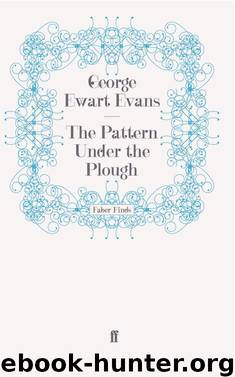The Pattern Under the Plough by George Ewart Evans

Author:George Ewart Evans [George Ewart Evans]
Language: eng
Format: epub
ISBN: 9780571286874
Publisher: Faber & Faber
Published: 2012-09-02T16:00:00+00:00
Some of the above experimental material was part of the traditional lore of North America; and a record of this suggests that11 generally speaking the waxing moon is the season for planting above-ground crops like grain and cereals; and the waning moon for underground or root crops. The same source gives an additional aspect of the moon belief. It was once thought that storing food below ground level helped to preserve it: silos were at one time not tall buildings but pits in the ground (the word itself is derived from the Greek word meaning pit). The ground, it was thought, helped to insulate the food against the harmful effect of moonlight. For the same reason pickling and canning were never done during the period of a full moon. This belief is not as ancient and ‘away-out’ as it appears, for there is a hard-to-believe report from the U.S. Weather Bureau (Department of Agriculture) in 1903:12 ‘That moonbeams or rays produce certain chemical results seems certain. It is known that fish and some kinds of meat are injured or spoiled when exposed to the light of the moon.’ All of which seems to echo the Psalmist who implies that the moon can cause a ‘stroke’ at night equal to that of the sun by day; and it argues that the East Anglian housewife who spreads her stained white table-cloth on the grass on a moonlight night to get out the stains is not hopefully indulging in sympathetic magic but is using this power of the moon’s rays to get it completely white for her.
The age-old belief that the moon affects the weather has also received examination in recent years by two groups of scientists working independently – one group in America, one in New Zealand. The two groups reported their findings in the American periodical Science13 and their main conclusion is that there is a marked tendency to heavy rain in the first and third week of the lunar month; that is, in the period immediately following the new and full moons, and a corresponding tendency towards a lack of heavy rain in the other two weeks of the month. They were able to offer no explanation of how the moon causes these effects; and in the short space of three years their observations appear to have gained one of those shelves in limbo which are reserved for interesting scientific facts that either have not gained general acceptance or have not been harnessed to practical use.
Download
This site does not store any files on its server. We only index and link to content provided by other sites. Please contact the content providers to delete copyright contents if any and email us, we'll remove relevant links or contents immediately.
| Africa | Americas |
| Arctic & Antarctica | Asia |
| Australia & Oceania | Europe |
| Middle East | Russia |
| United States | World |
| Ancient Civilizations | Military |
| Historical Study & Educational Resources |
Magic and Divination in Early Islam by Emilie Savage-Smith;(1500)
Ambition and Desire: The Dangerous Life of Josephine Bonaparte by Kate Williams(1344)
Bohemians, Bootleggers, Flappers, and Swells: The Best of Early Vanity Fair by Bohemians Bootleggers Flappers & Swells- The Best of Early Vanity Fair (epub)(1343)
Papillon by Henry Charrière(1310)
Twelve Caesars by Mary Beard(1256)
Operation Vengeance: The Astonishing Aerial Ambush That Changed World War II by Dan Hampton(1136)
What Really Happened: The Death of Hitler by Robert J. Hutchinson(1129)
London in the Twentieth Century by Jerry White(1113)
Time of the Magicians by Wolfram Eilenberger(1089)
The Japanese by Christopher Harding(1086)
Twilight of the Gods by Ian W. Toll(1084)
Lenin: A Biography by Robert Service(1045)
The Devil You Know by Charles M. Blow(985)
A Social History of the Media by Peter Burke & Peter Burke(936)
Freemasons for Dummies by Hodapp Christopher;(922)
Napolean Hill Collection by Napoleon Hill(902)
Henry III by David Carpenter;(891)
The Churchill Complex by Ian Buruma(881)
The Rise and Triumph of the Modern Self by Unknown(879)
